Masterpiece Story: L.O.V.E. by Maurizio Cattelan
In the heart of Milan, steps away from the iconic Duomo, Piazza Affari hosts a provocative sculpture by Maurizio Cattelan. Titled...
Lisa Scalone 8 July 2024
19 March 2024 min Read
Have you ever seen a bride more… angry? Should this not be the happiest day of her life? The Reluctant Bride or The Hesitant Fiancée by Auguste Toulmouche was painted in 1866. One user on TikTok published a video of it with Giuseppe Verdi’s Requiem. It quickly went viral as women reposted it with edits of supposed conversations that expressed their annoyance with classic misogynistic phrases, usually used by men.
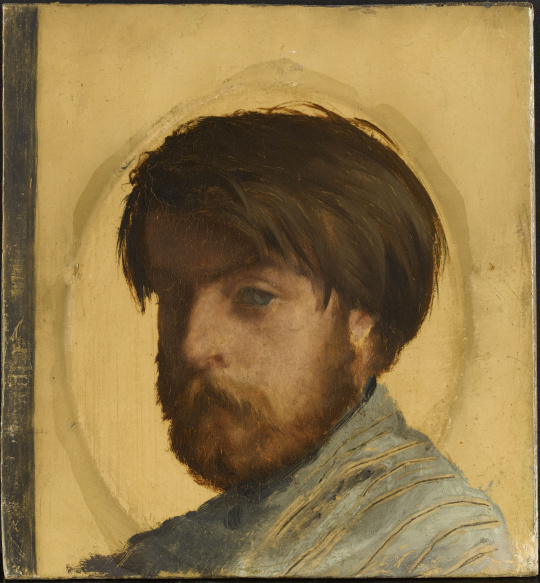
Jean-Louis Hamon, Auguste Toulmouche, mid-19th century, Musée National Magnin, Dijon, France.
Auguste Toulmouche (1829-1890) was a French painter born in Nantes. He had a comfortable life and could access artistic education in his youth. In 1846, he moved to Paris to study with the painter Charles Gleyre (1806-1874). Toulmouche focused on genre scenes, especially domestic interiors with wealthy women. He excelled at costume painting– the accurate reproduction of different clothes and fabrics like silk, lace, and velvet.
Although he enjoyed recognition at the Paris Salon, certain critics considered his pieces too frivolous and empty. For instance, the writer Émile Zola described his works as “delicious dolls of Toulmouche.”
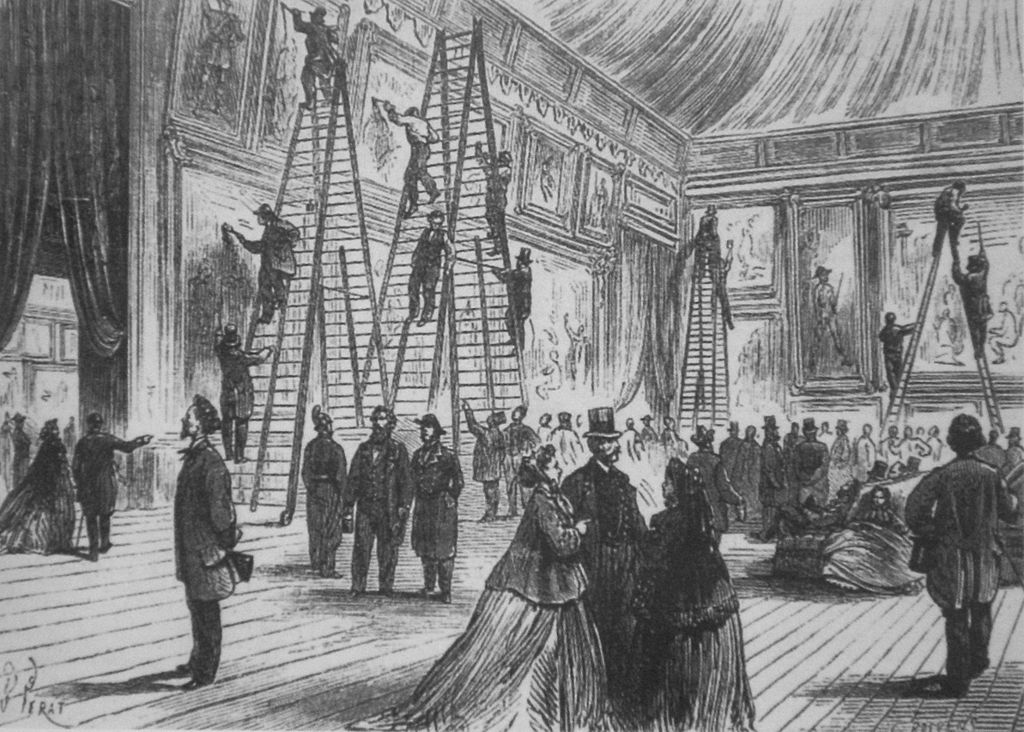
B. Perat, Varnishing at the Salon, 1866. Wikimedia Commons (public domain).
When Toulmouche made this painting, Impressionism was on the rise. However, Toulmouche stuck to the Academic style led by the French Academy. As such, he could exhibit his work in the Paris Salon of 1866. According to L’Univers Illustré (The Illustrated Universe), that same year, the painting also traveled to an exhibition in Bruxelles, Belgium.
The Reluctant Bride is a unique piece in Toulmouche’s portfolio. There are classic elements of his style, but there are also variations. Let us look closely at all the details.
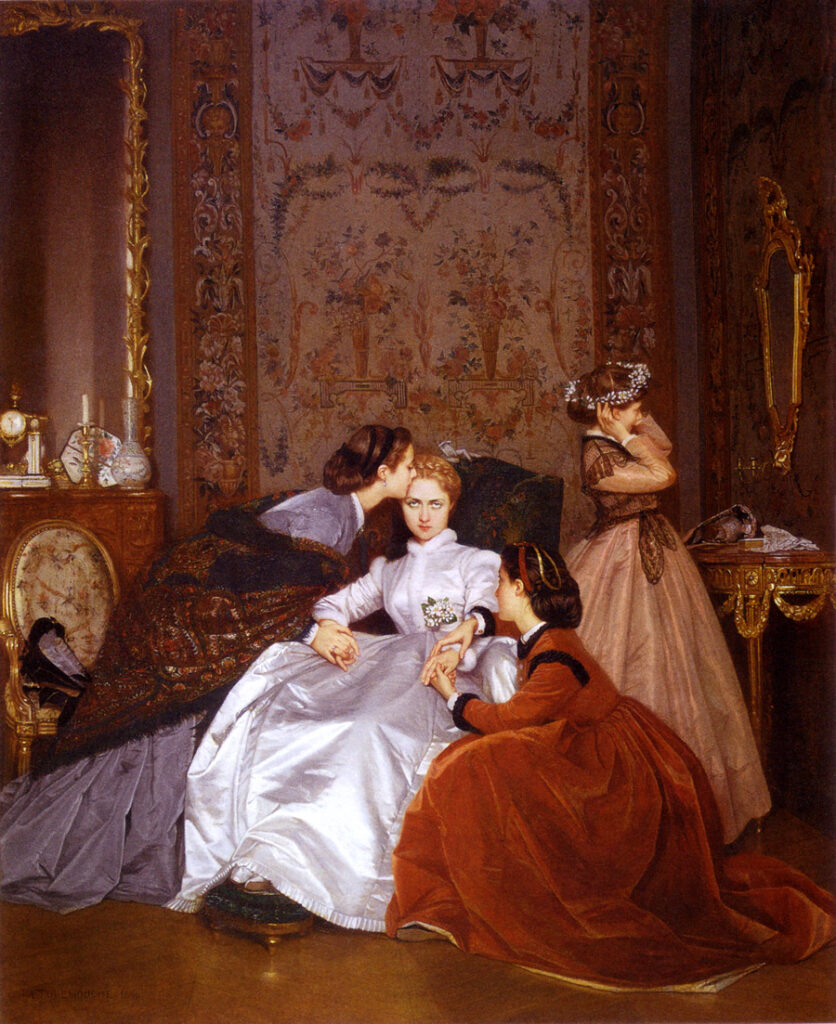
Auguste Toulmouche, The Reluctant Bride, 1866, private collection. Wikimedia Commons (public domain).
Toulmouche’s paintings generally featured only one or two women. Here, apart from our reluctant bride, there are three other women of different ages. This adds complexity to the scene as there are more relationships to portray.
By this time, Queen Victoria had famously popularized white as a standard bridal color. The bride wears a beautiful white silk wedding dress and shoes. Also, she keeps a small bouquet for the ceremony. Her position at the center of the canvas, the color of her dress, and her expression immediately draw the attention of the viewer.
Despite the clear annoyance of the bride, she has two friends next to her to console her. Are they her sisters or just friends?
On her right, the woman kissing her temple wears a purple silk dress, although not as shiny as the bride’s, and a brown dorman, or shawl, with embroidered patterns. On her left, another one kneels and holds her other hand. She wears a red velvet dress with black fur.
Toulmouche added a fourth girl in a pink silk dress. Her character adds a feeling of melancholy to the scene. Could it be the bride’s younger sister? She does not seem aware of the struggles of the bride. On the contrary, she admires her flower crown on the mirror to the right.
Maybe she is fantasizing about her wedding day, ignorant of all the social obligations that surround it that have nothing to do with love. Eventually, she will learn about them.
Around them, we see details of a luxurious room, possibly the bride’s. On the left, there is a mirror with a golden frame, a clock, a candle, and a jar. There is also a chair with embroidered cushions.
Behind them, there is a tapestry with floral designs that frame the group. This was a common element of interior design in the 19th century.
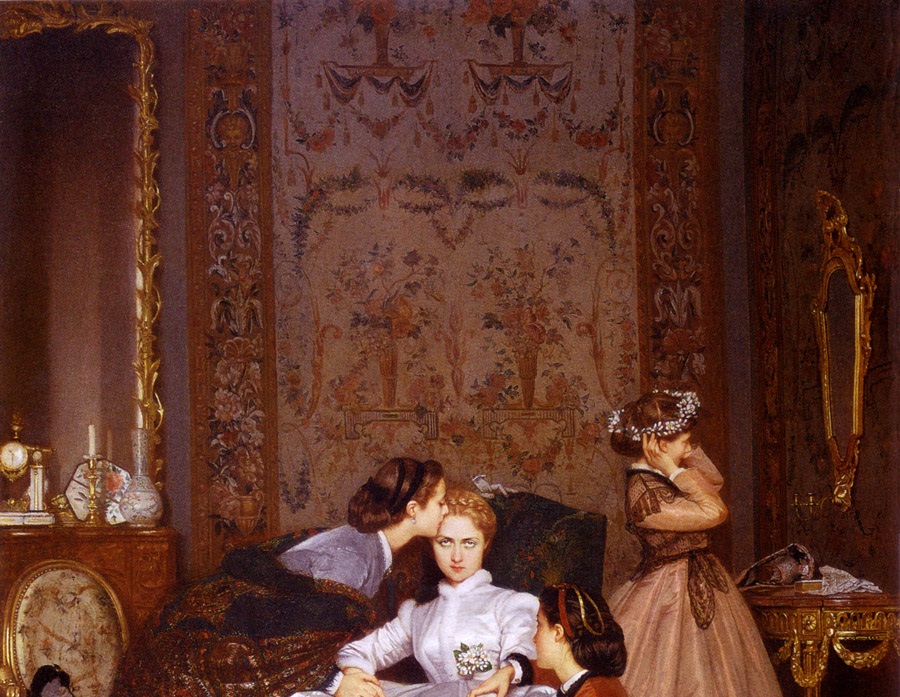
Auguste Toulmouche, The Reluctant Bride, 1866, private collection. Wikimedia Commons (public domain). Detail.
On May 23rd, 1866, Toulmouche’s bride was featured on the cover of L’Univers Illustrée. The original title in French was Le Mariage de Raison (The Marriage of Convenience). Clearly, this wedding was not the bride’s choice. As an upper-middle-class woman, she could not guide her decisions with her heart. Her future depended on relationships that benefited her family’s social status. Most likely, her parents arranged it without even consulting her, hence her annoyance and anger.
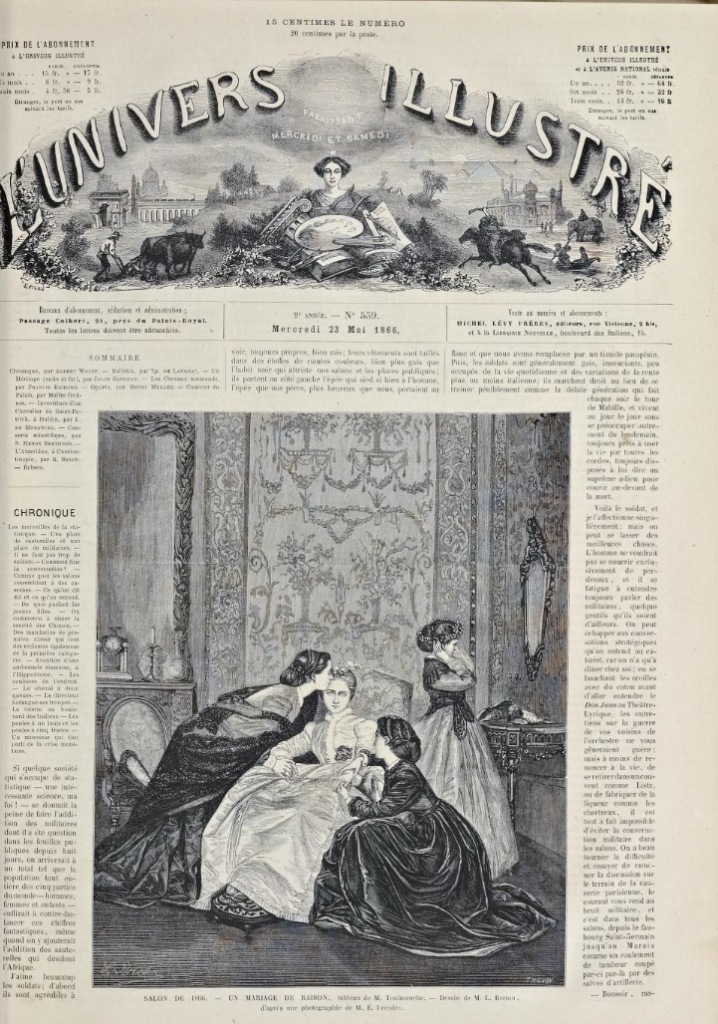
M. L. Breton, after Auguste Toulmouche, A Marriage of Convenience, 1866, L’Univers Illustrée.
In 1866, Félix Jahyer, a French journalist and art critic, published his account of the Salon. In it, he included an interpretation of Toulmouche’s The Reluctant Bride. This is quite a romantic description of the painting:
Submerged in a melancholic daydream, she [the bride] reveals regret for the past and a vague worry about the future. While she abandons her thoughts to a thousand concerns whose exact meaning escapes her, two of her friends try to detach her from her dark ideas.
Salon de 1866: deuxième étude sur les beaux-arts, BnF Gallica.
The comments against Toulmouche’s frivolous paintings continued with The Reluctant Bride. But even then, critics noticed something different in this one.
It is one of those small interior scenes that the artist excels at painting. They are always the same young women or girls, […] This time, it is this charming blonde that you know; dressed in her bridal gown, she is sitting, surrounded by her friends that console her, […] This delicate composition will not wait long to be, like its predecessors, popularized in engravings and photography.
Chronique – Nos artistes au salon de 1866, Le Cadre.
Dubois was not wrong. The painting has lived on to our days. Today, it has become a symbol of female rage. If 19th-century critics did not use “rage” to describe the bride’s feelings, it may have been because that was not an emotion that women should feel. However, today we can talk about it and empathize with her.
Félix Jahyer: Salon de 1866: deuxième étude sur les beaux-arts, 1866, BnF Gallica.
L’Univers Illustrée, 1866, Internet Archive.
Sandra Muniz: 1866 – Auguste Toulmouche, The Hesitant Fiancée, 2018, Fashion History Timeline.
DailyArt Magazine needs your support. Every contribution, however big or small, is very valuable for our future. Thanks to it, we will be able to sustain and grow the Magazine. Thank you for your help!